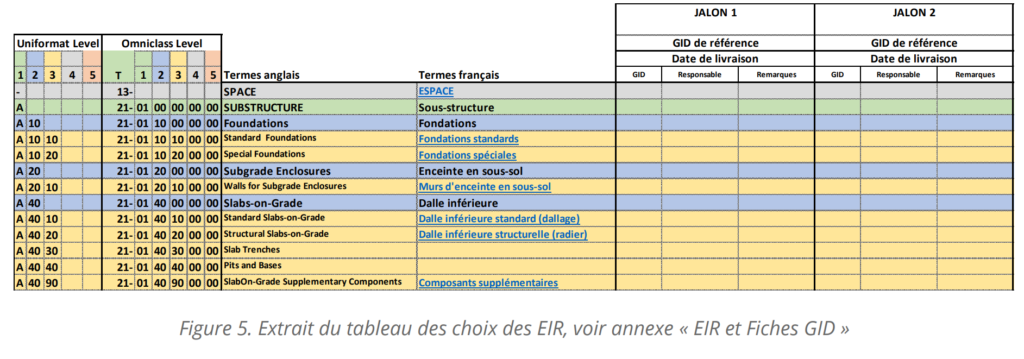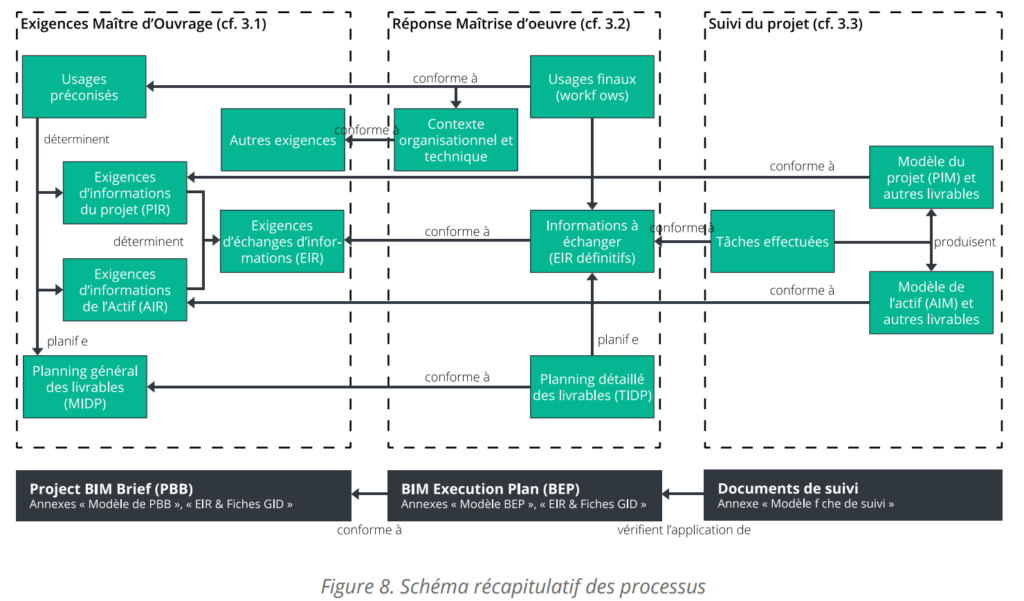3. Setting up a BIM project
3.1 Formalizing the project owner’s requirements: the Project BIM Brief (PBB)
The Project BIM Brief (PBB) describes the project owner’s expectations regarding the organization of a BIM project. A PBB template is provided in the appendix to this document. The methodology for composing a PBB is divided into several themes:
Why?
- Description of BIM objectives
- Description of recommended/required BIM uses
Who? What? When?
- Definition of the pre-established organizational context on the project owner’s side (with a detailed description of roles and competencies)
- Definition of information requirements according to milestones (PIR / AIR / MIDP)
- Summary table of recommended GID levels by object and phase (EIR)
- Other phase-specific requirements
How?
- Definition of the technical context and recommended means of exchange (software and exchange formats, naming conventions, modeling requirements, etc.).
- Defining available resources
- Other special requirements
Definition of general objectives and recommended uses of BIM
The owner defines his overall BIM objectives according to his own organization (management strategy, budget, regulations, policies, etc.). For example, he may only want to use BIM to operate his building, and not worry about how the design and construction phases will be managed. From this general strategy, he deduces the “uses of BIM” he recommends for his project (see 2.4).
Definition of information requirements and delivery milestones
Based on the uses it recommends, the project owner deduces its information requirements, i.e. the expected deliverables:
- during the construction phase for project management and decision-making (models, plans and other graphic deliverables for architectural assessment of the project; design reports for building performance assessment; schedule tracking; budget tracking, etc.). These are known as Project Information Requirements (PIR).
- during operation to manage the building. These requirements are defined at the start of the project, as some of the information will have to be delivered during the course of the project (e.g. space nomenclatures, space descriptions, equipment technical data, warranty information, maintenance schedules, etc.). These are known as Asset Information Requirements (AIR).
A set of information requirements should be drawn up for each decision point during the course of the project, for example at the end of each phase (APS, APD, etc.) and on the basis of other intermediate milestones.This means defining a precise phasing for the project. Based on these decision points, the project owner defines the milestones for delivery of the required project information: MIDP (Master Information Delivery Plan). These delivery milestones take into account the analysis time required by the MO between information delivery and decision.
Based on the PIRs and AIRs, and in line with the MIDP, the project owner is able to define the right “level of information need” (see 2.5) for each milestone, and who will be responsible for it. This step is called “Exchange Information Requirements” (EIR).
As a complement to the PBB model, we provide the document “GUIDE BIM LUX _Annexe – EIR & Fiches GID” to assist with this definition of EIRs. This file contains an initial table for selecting the GID level by type of object modeled (e.g. walls, doors, windows, slabs, etc.)8 and by phase (or milestone), while specifying the person responsible.

The tables that follow contain the “GID sheets”: they detail the correct levels of geometric information9 , non-geometric information and documentation for the different types of object at the different phases of the project.
The content of the GID sheets is an ideal to be reached, a level deemed “sufficient” at “common” milestones. The project phases associated with each level are reference phases: this association is by no means restrictive, and may vary according to need. Given the variety of projects, it is clear that cases will vary: consequently, the GID levels presented represent neither an absolute minimum to be achieved nor a maximum limit.


Definition of the reference information made available by the MO
The project owner’s team will provide reference information to the design/build teams, which will then have to comply with it:
- Information on the project context (site and surroundings, existing buildings, current standards, etc.).
- Resources to be used such as document templates, model structures, BIM object libraries, graphic charters, guides, etc…
Definition of the common data environment (CDE)
The project management team is responsible for setting up the common data environment (CDE), which will be used throughout the project to support the collaborative production of information. The CDE respects the main principles described in the previous chapter (naming management, version management, status management, security, etc.).
Definition of specific rules concerning the production and exchange of information
The MO will have to formalize precisely the obligations of each party concerning the production and exchange of information: use of the CDE, use of shared resources, intellectual property rights and reuse of data after the project, etc.
Remarks
1/ The repetition of project owners’ projects can help produce a generic set of requirements that can be reused on all their projects when writing each new PBB. 2/ The project owner’s team will need to strike a balance in terms of the precision of these requirements:
they must be precise enough to provide a framework for the project, while not being too restrictive
for the future work of the design/build teams.
3/ Part of the PBB (such as the definition of the CDE) may not be defined by the
responsibility of future contractors (through contractual commitments). All
will depend on the Owner’s involvement in the project’s BIM approach.
3.2 Formalization of the proposal by the project owner: the BIM Execution Plan (BEP)
A “BIM Execution Plan” (BEP)10 describes how collaboration on a BIM project is organized, in line with the client’s requirements (see 3.1) but taking into account the specific organizational and technological context of the project. In other words, it is an updated and completed version of the PBB based on the response to the client’s requirements. It then takes on a contractual value and becomes the reference document on which everyone can rely at any time in order to know :
- What is expected of him
- What he can expect from others
A BEP template is proposed in the appendix: “BEP template”. The person who assumes the role of BIM Manager (see 2.2) in the project is responsible for creating, managing and distributing this document. It must be updated as the project progresses, and must be the subject of consensus.
Note: If required by the tender, a first version of the BEP must be created before the BIM Manager assignment is contracted. This is referred to as a pre-contract BEP. The winning BIM Manager’s proposal will then be completed to become the project BEP (post-contract). The methodology for composing a BEP therefore follows the same themes as the PBB, while supplementing it with the guidelines that will actually be implemented during the project:
Why?
- Project description
- Description of the final BIM uses to be implemented
Who? What? When?
- Definition of the complete organizational context (with a detailed description of roles and competencies)
- Summary schedule of milestones and deliverables, including intermediate deliverables (TIDP)
- Work and exchange processes based on usage and milestones
- Summary table of final GID levels by object and milestone/phase (EIR)
How ?
- Definition of the technical context and final means of exchange (software and exchange formats, naming conventions, modeling requirements, etc.).
- Other specific requirements (e.g. model checking, georeferencing, model size, etc.).
These three stages are followed jointly and iteratively until the end of the project. All decisions must be taken by consensus.
Reminder of objectives and definition of BIM end uses
General information about the project is taken directly from the reference information provided by the project management team. It is then necessary to specify the uses that will be implemented. Here too, the final uses will be determined in accordance with the Owner’s requirements (recommended uses). For each use, it is advisable to define a work and exchange process (workflow) which will describe precisely the order in which tasks will be carried out, by whom and where the various milestones (verification, delivery, etc.) will be placed.
Defining the organizational context
All organizations involved in the project must be known and identified. In addition to general information (name, contact details, role, etc.) it is necessary to describe the software used. For each organization identified, it is necessary to identify the players (or groups of players) by their roles (including “BIM Manager”, “BIM Coordinator” and “BIM Modeler”), responsibilities and skills.
Note: in the case of a pre-contract BEP, the teams described are the known bidding teams. Secondly, the aim here is to describe the situation once the companies and individuals are contractually committed. This implies that the assessment and verification of their skills prior to engagement will already have been carried out. If, however, shortcomings are identified during the course of the project, steps will have to be taken (external support, training, etc.).
Definition of information exchanges in response to needs of MO
The final planning of deliverables and information exchanges proposed by the design/build teams must take into account the Owner’s information exchange requirements (EIR). However, they may differ, and must be agreed by all stakeholders .They will depend on each individual’s ability (in terms of skills and software) to provide this information, and should not be a hindrance to the project.
In practical terms, this means “updating” :
- Master Information Delivery Plan (MIDP) in detailed planning (“TIDP” for Task Information Delivery Plan11)
- The project owner’s EIRs with the GID detail levels that will actually be implemented at the various milestones and the appropriate persons responsible (see appendix “EIRs & GID sheets”).
Definition of the technical and other resources used to meet the MO requirements
- The BIM Manager specifies all information delivery methods, always in compliance with the Owner’s requirements, such as :
- The BIM Manager specifies all information delivery methods, always in compliance with the Owner’s requirements, such as:
- The formats in which files will be exchanged between participants
- General modeling rules (maximum size, model breakdown, classification, project geo-referencing, units of measurement, etc.).
- The checks that will be put in place
- Using the CDE
Remarks
1/ Compliance with the final BEP (post-contract) must be the subject of a contractual commitment. It must therefore be the subject of a consensus between all the parties involved, who will therefore not be free at any time to “stop” due to lack of competence or lack of financial resources (software licenses, training, etc.).
2/ The BEP must be updated whenever there are changes to the elements it contains. It is available to all collaborators via the project’s CDE.
3.3 Project follow-up
The project’s BIM Manager is responsible for ensuring that the BEP is respected. It is advisable to hold regular coordination meetings (whether or not they are specifically dedicated to BIM) and to set up a monitoring document that will enable the project to be supervised by the actions to be taken, between each milestone and for each company involved.
We propose a sample monitoring document in the appendix: “BIM Monitoring Sheet”. The actions to be identified are of various kinds, such as :
- Management: to solve an organizational or administrative problem
- Reminder of a service to be distributed: on the basis of the service schedule set out in the BEP.
- Information to be completed/provided: whether geometric, non-geometric or external documentation.
- Etc.
Depending on the assessment, it is recommended that additional reports be appended to these monitoring sheets for :
- More explicit details of an identified non-conformity
- Propose a formalized solution (technical or organizational) that can be used directly in the event of a stoppage, but that is also sustainable for similar cases in the future.
At the end of a phase (or an intermediate milestone), a final assessment is carried out on the basis of the models and deliverables, so that the BIM Manager can certify that the BEP has been complied with, and the project moves on to the next phase. The tracking document is then closed and a new one created.
3.4 Summary diagram (workflows)

